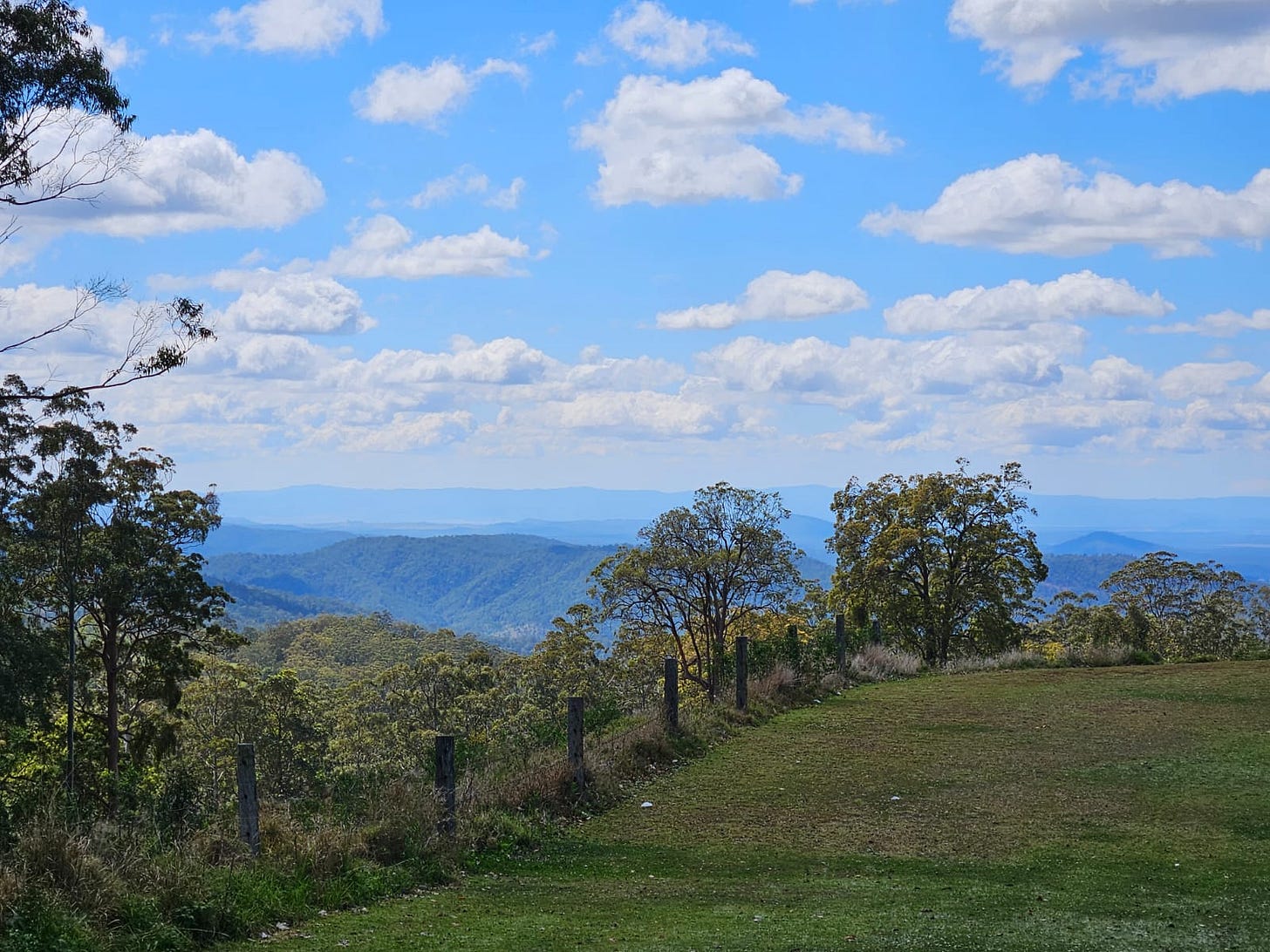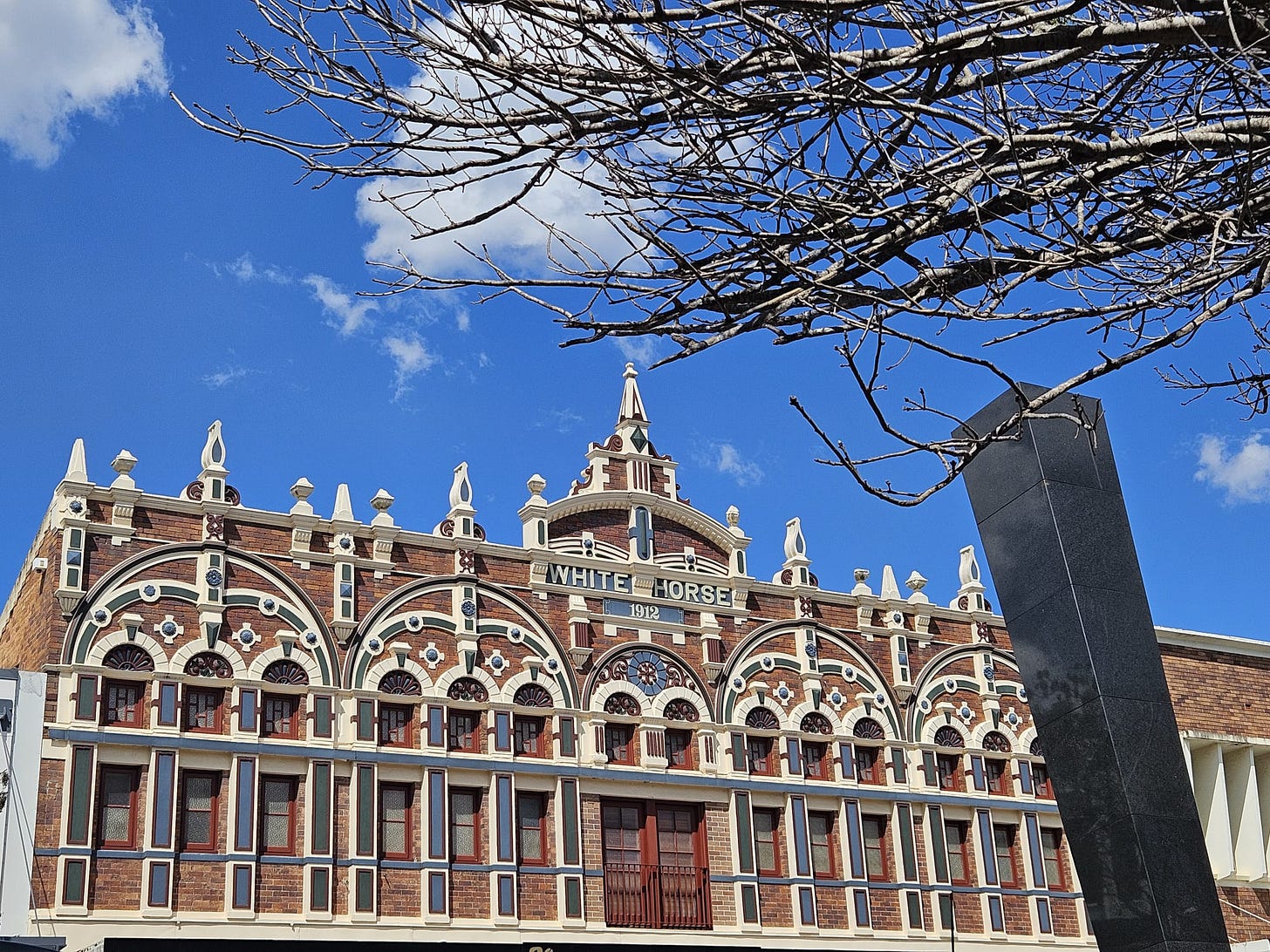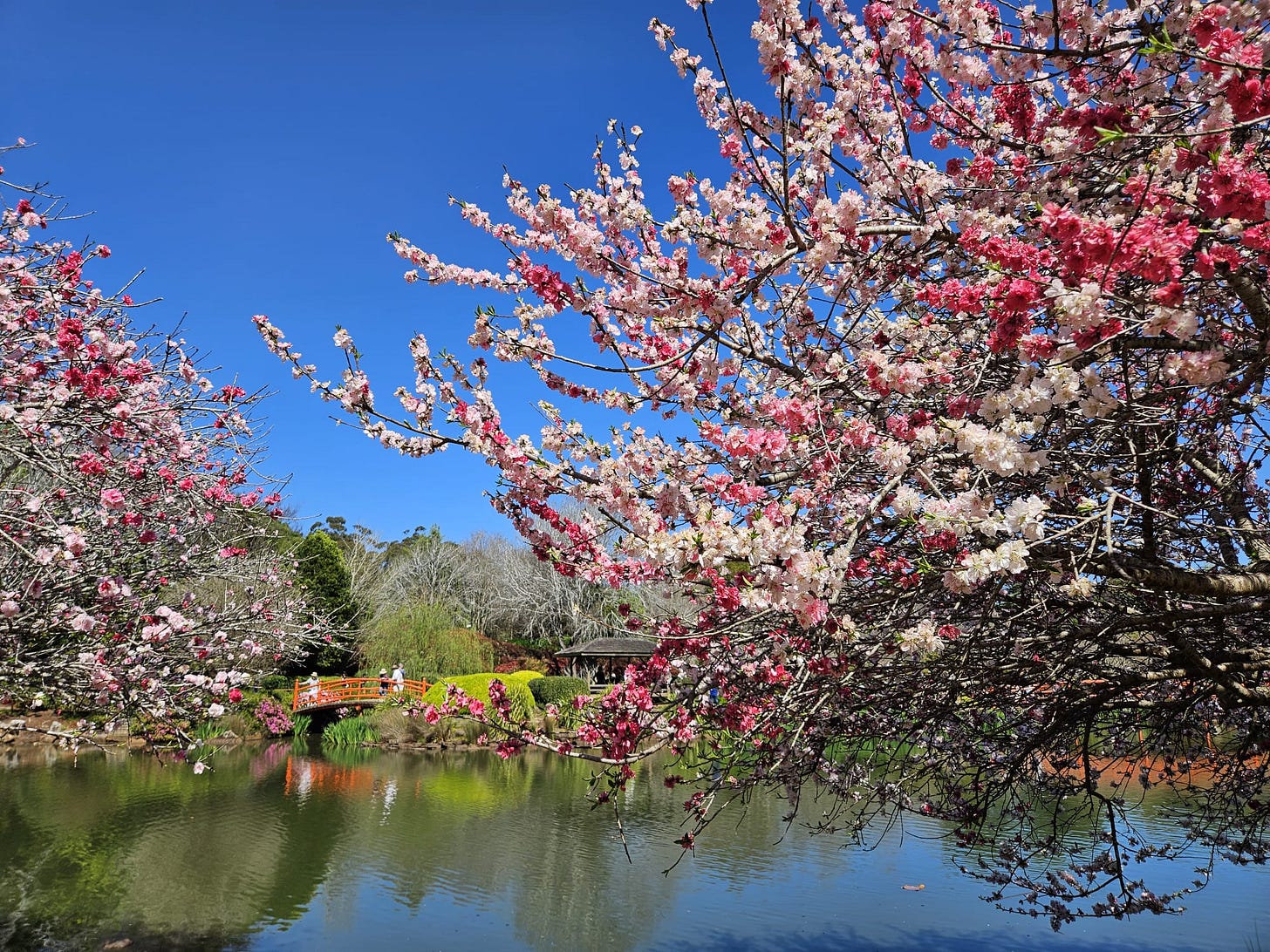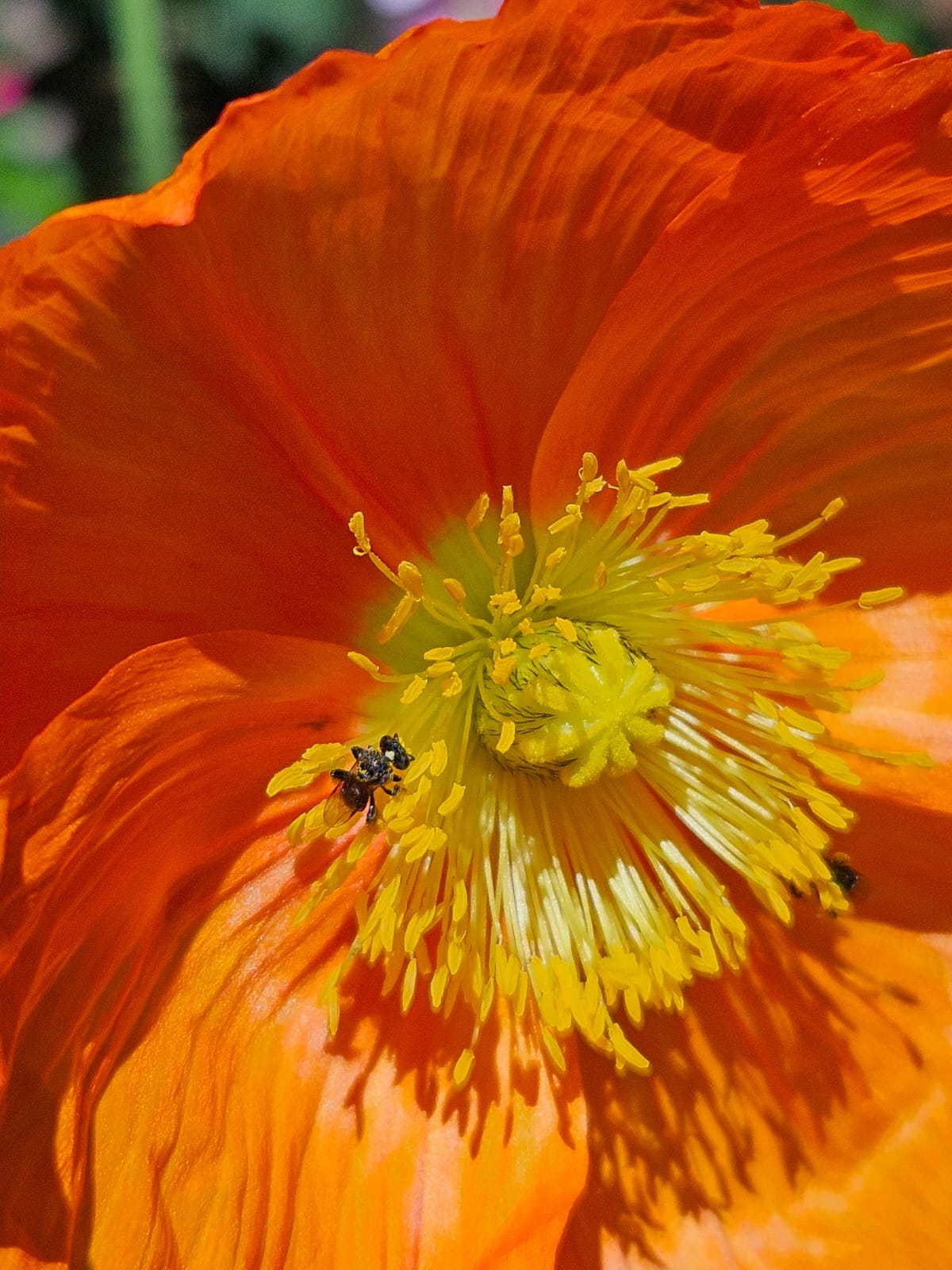Love on the High Range
Glimpses of a beautiful life
Toowoomba feels like a cross between Los Angeles (albeit with much cooler weather) and an American frontier town from the days of the Wild West. From the centre of town, the four-lane highways stretch out towards the horizon, lined with squat bungalows and old-fashioned motels, with fast food joints like Red Rooster and Hungry Jack’s at the intersections, together with the odd branch of Café 63, a kind of diner with a view of passing cars and perhaps the longest menu I’ve ever seen, in a font that made me scrunch up my eyes, despite my glasses and with the “extras” helpfully arranged in alphabetical order from A for Avocado to Y for Yoghurt, Greek. In the town centre itself, stately old civic buildings with ornamental brickwork, stained glass details and clock towers alternate with vacant storefronts displaying “for let” signs alongside the usual establishments of small town decadence: gambling dens, gentleman’s clubs, vape shops, with some welcoming old-fashioned pubs and a few country goods stores. Instead of crinolined ladies with parasols and gun-toting gents in slouch hats and Errol Flynn moustaches (who would surely not be too out of place in this setting), we have the familiar mix of Aussies—Brits on holiday, relaxed, down-to-earth, no-nonsense—and a much more generous smattering of more recent immigrants than any English town of this size would be likely to have: tall, ebony Sudanese men, Indians galore (including half the staff at the aforementioned Café 63), Sri Lankans, Filipinos.
The attractions of Toowoomba are not civic but bucolic. Up on a high ridge overlooking a basin of hills, it is approached from Brisbane by a winding road that gradually climbs through lush woodland in a coach journey that is the twin of the trip from Sydney to Canberra. The town has several lovely, landscaped parks. Queens Park with its extensive lawns and magnificent trees from worlds old and new: English oaks and London planes alongside Kauri, Bunya pines and towering blue gums; Laurel Bank with its classical nude sculptures, topiaried bushes and canopy of camphor laurel; and the Japanese Gardens with their picture-perfect red arched bridges and rows of cherry trees, currently adorned with china white, flamingo pink and magenta blossoms in our upside-down spring. In my photos, it could be mistaken for Kyoto: in real life, the nasal accents, the cones of soft serve dusted with pink sherbet and a squat tree whose branches are heavy with the plump white and black bodies of ibises (the ubiquitous bin chickens) mark it out as unmistakably Australian.
I’ve come here for the annual flower festival and every garden is a riot of chaotic colour, dominated by pinks, purples, oranges and yellows: primroses and dahlias, foxgloves and azaleas, Oxford-blue delphiniums, trumpet-shaped lemon-yellow clivia and—my favourite—endless beds of fluttery-headed citrus-coloured Icelandic poppies. In my head, I’m singing, “‘Oranges and lemons,’ say the bells of St. Clements.”
I am staying above the town, on an avocado farm. Beyond the fire break around the house, the vegetation is arranged in layers: a stand of bamboo, a plantation of squat finger lime trees, beyond them the avocado trees and beyond that the lovely forests of eucalyptus and pine and the line of blue mountains on the horizon. A glossy black kelpie with tan beard and eyebrows sits at my feet as I type and intermittently paws me for attention. I am once again staying at a farmhouse with a couple in their fifties: once again I am amid the prosperity amassed during a life of hard work and careful husbandry, in a home abundantly comfortable and welcoming—with a fire pit around which to drink champagne before slurping up oysters adorned with finger lime pearls.
What strikes me most about this couple, though—and strikes me with almost painful force, as I envy and long for such a thing for myself so much—is how much they love each other. And not just love, but are in love with a quiet intensity that must surely be rare in people who have been married for thirty years—though the romantic in me hopes that it is not too rare. They are very similar: slender, highly articulate, well-educated, worldly and yet very warm. The hallmarks of a lifetime in the armed forces are everywhere apparent in the high conscientiousness, bright alertness and discipline. Like-minded people often find each other, of course—that’s assortative mating for you—and they also, surely, grow more similar over the years and decades.
This is a difficult thing to write about for several reasons. For one, I am afraid of sounding corny or of making them seem saccharine or boring. “Every happy family is happy in the same way,” writes Tolstoy. But he was a novelist and novels require conflict. The course of true love never did run smooth—in a play. Where would be the drama in that? But luckily, in real life we do not have to serve the demands of a narrative structure.
For another thing, though, I am worried about seeming creepy, about making assumptions about the emotional intimacies of two people I barely know. Perhaps it has not always been this way for them: perhaps there has been more turbulence and strife in their long relationship than I would ever guess at. Perhaps I am idealising their marriage too much. Perhaps I am misinterpreting. But I don’t think so. It seems so obvious to me, so tangible—as little of a secret as the produce of the farm proclaimed on a sign at the entrance to the driveway: avocados, finger limes, rhubarb. It’s as palpable as the honeyed scent of the avocado trees when their tiny yellowish-green blossoms are open to the bees; it’s as blatant as the lipstick pink of the galahs’ feathered bellies, blushing as it catches the golden light of evening—the galahs, who fly in graceful low arcs and land delicately on fence posts, almost always in pairs. It’s in the way he reaches for her hand when they’re walking or places an arm around her shoulder and snuggles in under a shared umbrella; it’s in the tone of her voice when she makes a diminutive out of his name. It’s in a thousand little allusions—that’s when we met; we went there; we used to do that—said with a detectably warm note.
There on the high ridge by Toowoomba, above the steamy heat of Brisbane, where the wallabies lope along beside the red-clay track as we take our morning walk, love is flourishing. There is a rustle in a Morton Bay fig and amid the shiny dark foliage flashes of a vibrant emerald green and a mustard yellow are visible: two Wompoo fruit doves. A pair of Willie wagtails are fluttering back and forth to a nest atop the spindly bare branches of a deciduous tree. A king parrot flashes his scarlet undercarriage as he flits among the eucalypts, his queen close behind. Two kookaburras cackle at me from their perch side by side on a power line. Every creature seems to have its mate.
It’s too late for me to experience a life lived in partnership. The years have passed and the opportunities have been missed or squandered. I’m late to the feast; I’m the last one at the harvest. Now, I’m kissing only soft dog fur and the only ears into which I whisper “I love you” are the velvet ears of a kelpie. But I know my luck could change as quickly as the high-altitude weather shifts from grey drizzle to radiant sunshine. It’s the first day of spring and already the air is bright with promise. I will take it as a good omen.






The beautiful melancholy of a live lived